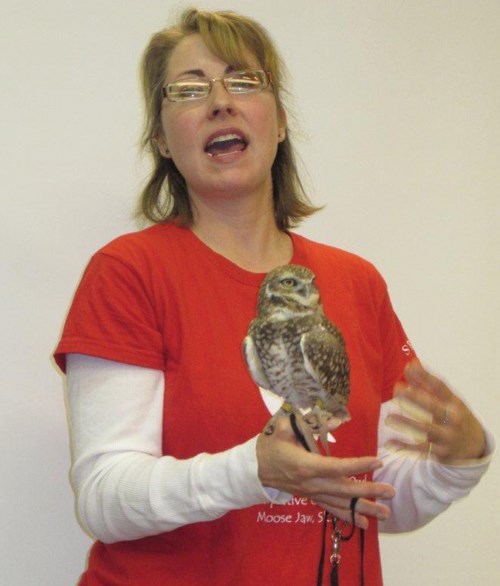A larger than usual crowd came out to the Stoughton library the evening of Monday Nov. 15th. for a most interesting presentation.
Visiting the library were Lacey Weekesthe Habitat Stewardship Coordinator from Nature Saskatchewan in Regina and Lori Johnson from the Saskatchewan Burrowing Owl Interpretive Centre in Moose Jaw.
Nature Saskatchewan is a conservation and cultural organization of naturalists with a vision of"Humanity in Harmony with Nature". To this end the program exists to educate people about the need to conserve natural habitat and native species and give land owners an opportunity to participate in their conservation programs.Two such programs are Operation Burrowing Owl and Rare Plant and Rescue.
Lori Johnson introduced the audience to 5 year old Trooper, a male Burrowing Owl that is considered an endangered speciesin Canada. Trooperis one of three "ambassador" Burrowing Owls whohave been hand raised for educational purposes. These owls are endangered for a variety of reasons: their habitat is disappearing and. they are the only owls that nest inexisting underground burrows. They rely on gophers, badgers and foxes for their homes. Flooding of the burrowswill kill the young and they are also preyed upon by badgers, hawks,dogs and cats and larger owls especially the Great Horned Owl. They are susceptable to Avian flu and West Nile. As well if they miss migrating (they migrate individually)the first year of their life for whatever reason they will never migrate again. Their mortality rate is great and 96% never reach breeding age.. The life span in the wild is 3-5 years and in captivity it is 8-15 yrs. At the present time there are less than 800 in BC, Sask. and Manitobawhere they are usually found. They can be found in Stoughton and area.
These owls are bornthe end of June on average 8-9 in a clutch with their eyes closedand are full grown at 6 months. Mature weight is 1/4 lb. and 9-11 inches in height. Both male and female have the same coloring.The aggs are all white and round and smaller than ping pong ball.
Another species that was discussed was a relative to the Killdear, namely Piping Plovers. These birds are found in the corner of southern Saskatchewan and nest only on shorelines next to water. Their habitat is also being threatened. In the spring of 2008, Nature Saskatchewan initiated Plovers On Shore (POS) as another ofStewards of Saskatchewan programs. This successful program works with landowners who havePiping Plover habitat to voluntarily conserve these shorelines and wetlands for Plovers and other prairie species.
Mentioned also was another critically endangered birdspecies in Canada: the Loggerhead Shrike. This bird of prey has no talons and is referred to as the Butcher Bird because of its unusual feeding habits. It catches his prey and impales it on thorns or barbed wire.
There was lots of literature available for people to take home and read.




